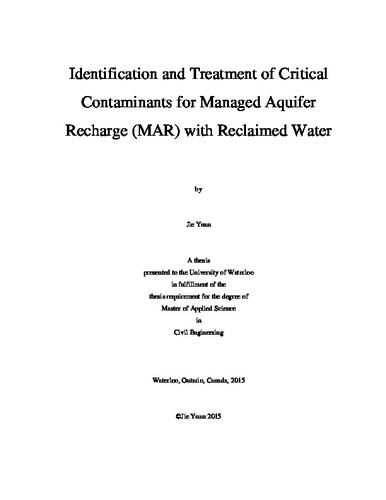| dc.description.abstract | Residential and employment growth places great pressure on well-based potable water supply and stream-based wastewater treatment systems, which are common in many areas of Canada. To ensure that increased potable water demands and associated increases in wastewater discharges can be met, sustainable water management strategies are needed. One water reuse application, managed aquifer recharge (MAR) with reclaimed water, has been recognized as a potential strategy for indirect potable reuse. However, MAR systems are quite complex and contain a lot of uncertainties. In particular, an investigation of contaminant removal to achieve water quality levels suitable for MAR is needed. To determine water quality limits for MAR with reclaimed water, current water reuse regulations or guidelines which specify MAR requirements and worldwide MAR case studies were first reviewed. The critical contaminants for MAR with reclaimed water were then identified based on wastewater treatment plant (WWTP) effluent monitoring data from a case study and literature data. Water treatment technologies to remove these identified critical contaminants were finally evaluated and the feasible treatment train was recommended for the pre-treatment of MAR with reclaimed water.
The establishment of a MAR system depends on the source of recharge water, the selection of a recharge method and site, the type of water treatment systems, and the ultimate purpose of recovered water. Various components of a MAR system are closely related and integrated. At present, detailed regulations or guidelines to guide MAR with reclaimed water are unavailable in most countries. However, a regulatory framework can be proposed through a review of the currently available regulations/guidelines. Various existing MAR projects in many countries such as USA, Australia, Belgium, Israel, and China can be analyzed in the context of this framework and used as a reference for the implementation of future MAR systems.
The identification of critical contaminants for MAR with reclaimed water is important for MAR implementation. However, the lack of MAR regulatory documents in Ontario and contaminant monitoring data increase the difficulties of this task. To solve the problem, a list of recharge water parameter limits for MAR was defined and an approach to select critical contaminants for MAR was developed. Predominant contaminants, which are the residual regulated substances in a wastewater effluent for which concentrations are higher than the defined recharge water limits, were identified based on WWTP effluent monitoring data from a case study. Potential microbial and organic contaminants, which are included in the defined regulated contaminants list and have high possibility to exist in the effluent, were selected based on the occurrences and concentrations of regulated contaminants in wastewater effluents from the literature. Potential emerging contaminants, which are not regulated but may be important for MAR with reclaimed water, were also chosen according to their consumption volumes, bioaccumulation, ecological and health effects, and occurrences in wastewater effluent from published studies. Finally, a list of critical contaminants for MAR with reclaimed water, which comprise these three types of contaminants, was determined.
An adequate water pre-treatment system is needed for MAR with reclaimed water to remove a wide range of residual chemical and microbial contaminants in wastewater effluents. Different types of water treatment technologies, including conventional wastewater treatment, conventional drinking water treatment, and advanced processes including membrane filtration and oxidation processes, can be helpful to remove critical contaminants for MAR with reclaimed water. Based on the identified types of critical contaminants, different treatment alternatives were proposed and evaluated based on previous studies available in the literature. Through the combination of different treatment units, potential treatment trains were proposed. Based on this initial assessment, the most cost-effective treatment train of ultrafiltration, reverse osmosis, UV-based advanced oxidation processes (AOPs) for the pre-treatment of MAR with reclaimed water was proposed. This treatment scenario was compared with the normal treatment trains in previous MAR case studies for potable reuse. It was found that this treatment is more robust but may be more expensive.
Overall results of this work established methods to evaluate MAR pre-treatment strategies that can be used by municipalities that are planning MAR with reclaimed water. As well, this research can be applied to assess the feasibility of MAR, but will need to be taken together with other aspects (recharge sites, recharge methods, recharge facilities) to assess overall applicability of the work. | en |

